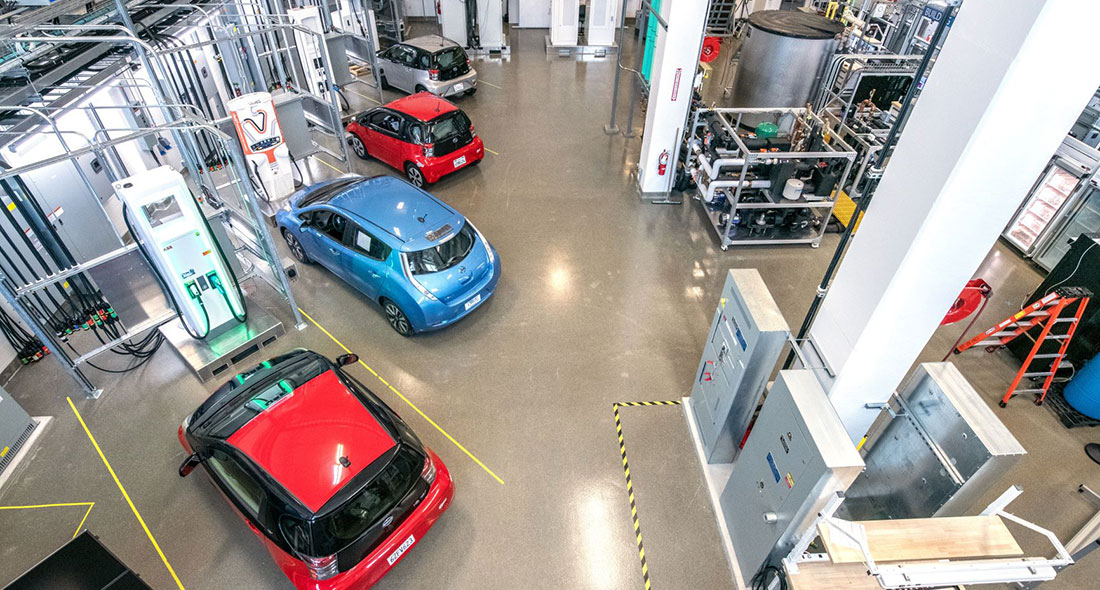Advanced Charging Systems Research Moves Consumer and Commercial Electric Vehicles Faster and Further

Demand for electric vehicles (EVs) has never been higher, with the number of plug-in EVs on the road expected to reach seven million by 2025. However, consumers and commercial fleets alike are calling for significant improvements in battery performance and charging infrastructure.
To meet those challenges, researchers must balance increasing demands for power with the existing grid infrastructure to move energy quickly, safely, and securely. National Renewable Energy Laboratory (NREL) stands at the forefront of this groundbreaking work, combining extreme fast charging (XFC) initiatives with grid integration opportunities to meet energy demands.
XFC is key to recharging faster and traveling further, providing alternative options when overnight charging at home is not feasible. In partnership with the U.S. Department of Energy’s eXtreme Fast Charge and Cell Evaluation program, NREL researchers are working toward improving cell chemistries to enable charging speeds on par with conventional refueling methods. This work focuses on thermal management practices, addressing heat generation concerns as battery cells recharge.
Even with battery improvements, electricity demand during peak periods can significantly impact costs for fast-charging applications. In response, NREL is exploring EV grid integration as part of its ARIES initiative at the Energy Systems Integration Facility (ESIF), where researchers assess the latest grid modernization designs alongside high-performance computing capabilities. One area of modernization is site-integrated EV charging, which takes into consideration behind-the-meter storage (BTMS) energy integration to manage EV charging in unison with building loads. BTMS systems include renewable energy, such as photovoltaic generation, as well as thermal energy, such as refrigeration, ice storage, and combined heat and power.
Exploring Energy Storage Strategies To Meet Building and Transportation Needs
The Electric Vehicle Research Infrastructure (EVRI) evaluation platform at ESIF uniquely positions NREL within the national laboratory complex by putting transportation researchers alongside commercial building and energy storage experts to collaboratively investigate state-of-the-art strategies to manage the grid impacts of high-power, site-integrated EV charging. By studying EVs, buildings, and infrastructure together as key components of a larger electrical ecosystem, researchers are better positioned to examine the technical details for developing flexible, cost-effective control systems and strategies that balance the power demands of EVs with the realities of buildings and the grid. This type of integrated energy management approach will prove crucial. To wit: While buildings are responsible for 75% of the nation’s total electrical load, the increasing number of EVs on the road reveals the need for five million charge ports by 2025.
By pairing a variety of EVs—including the notoriously difficult-to-electrify medium- and heavy-duty fleet—with a range of extreme-fast-charging equipment, simulators, and distributed energy resources (DERs), researchers can measure how varying loads and control systems affect the health of the broader system. This flexible infrastructure featuring AC and DC charging with a variety of grid voltages lets them predict how targeted interventions—like BTMS or on-site renewable energy generation—can help optimize on-the-ground EV charging together with the electrical loads of nearby buildings, a critical step for lowering the cost and time it takes to charge EV batteries.
This one-of-a kind research platform also enables other new capabilities in NREL’s robust portfolio, with a focus on optimizing charging infrastructure and systems to enable EV adoption. These capabilities include:
- One-of-a-kind research platform with 20 MW of integrated grid and renewable assets, interconnected by cyber-physical links to study large-scale energy systems integration
- High-performance computing—amplified by a virtual emulation environment powered by NREL’s eight-petaflop supercomputer—with co-simulation of millions of devices and their interactions across energy domains
- Real-time digital simulation—both grid-side and vehicle-side
- Utility-scale infrastructure to characterize innovative technologies—including extreme fast charging, battery energy storage, and electrolyzers—and their integration with the grid, on-the-ground EV charging, and the electrical loads of nearby buildings
- Diverse charging and energy storage equipment, including two 350-kW chargers (with two more expected soon), four level-2 chargers, a 50-kW charger, and a 40-kWh battery energy storage system
- State-of-the-art distributed energy resource control and management applications to model EV charging and coordination dynamics, enabling the assessment of how varying loads and control systems affect the health of the broader energy system.
Within the EVRI evaluation platform, NREL is expanding its battery performance and charging infrastructure research to further explore dynamics in response to different battery chemistries, capabilities, and thermal designs as well as varieties of EVs and EV supply equipment. In addition, the complementary Commercial Buildings Research Infrastructure evaluation platform features BTMS and controllable building loads alongside XFC and other connected and controllable EV charging technologies, enabling enhanced research in these arenas.
Extreme Fast Charging Research Workshop Pinpoints Future Research Needs
NREL led an in-depth review of current XFC developments and research opportunities at its pioneering Commercial Vehicles and Extreme Fast Charging Research Needs Workshop. More than 40 U.S. Department of Energy staff, national laboratory representatives, and industry experts attended the workshop, focusing on the electric charging challenges facing medium- and heavy-duty commercial vehicles and the potential for integrated XFC in these applications. For more information about the specific topics covered in the workshop, see the workshop agenda and presentations.
Medium- and heavy-duty EVs present unique challenges to the charging infrastructure. A viable XFC system must be capable of integrating with the electric grid, renewable energy generators such as solar and wind, and stationary energy storage without adverse impacts. Workshop attendees identified stakeholder collaboration as an essential factor to ensuring widespread implementation. Future research opportunities were identified, including the creation of total-cost-analysis models for commercial charging infrastructure and development of a battery design specific to EVs that operate 24/7.
Learn more about NREL's transportation and mobility and electric vehicle grid integration research as well as its integrated modeling and analysis tools.
Last Updated May 28, 2025
